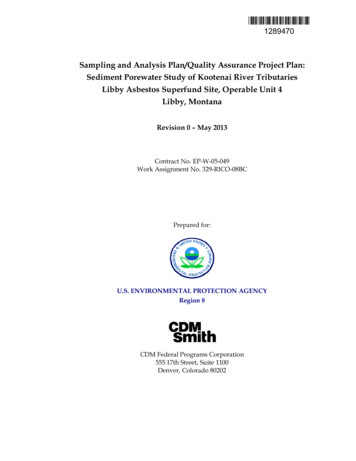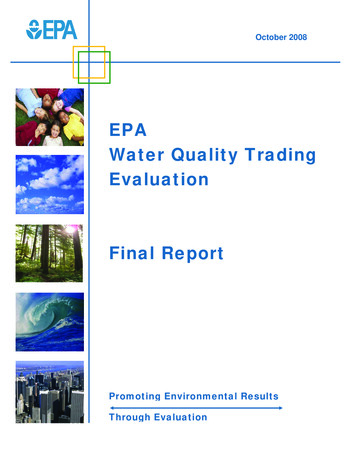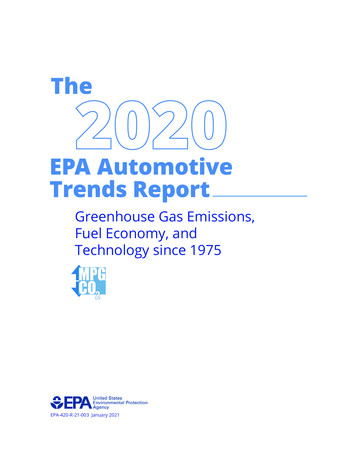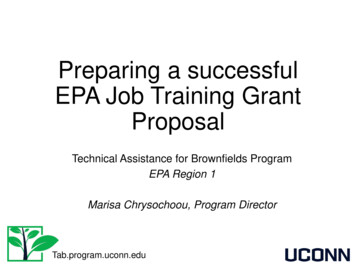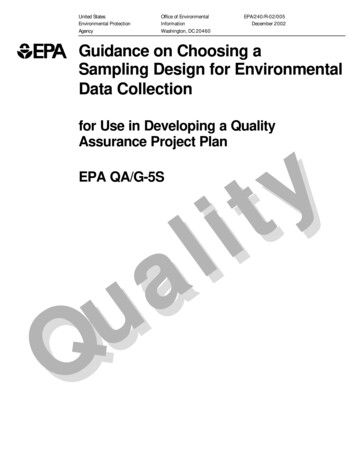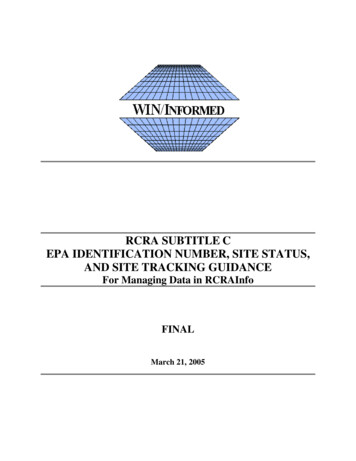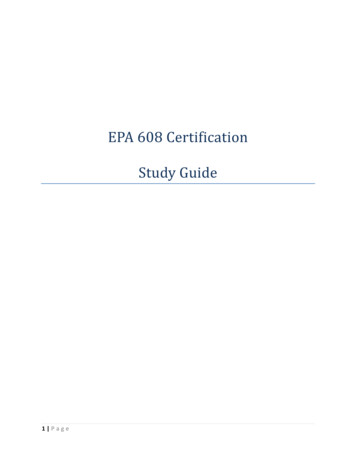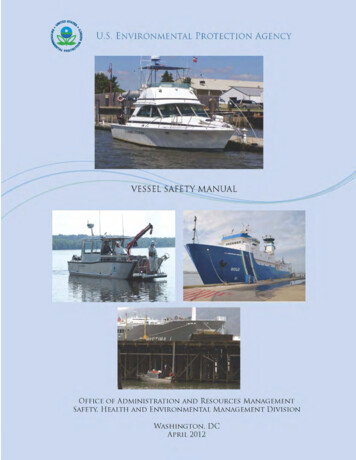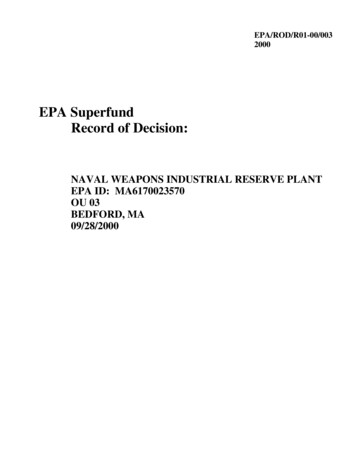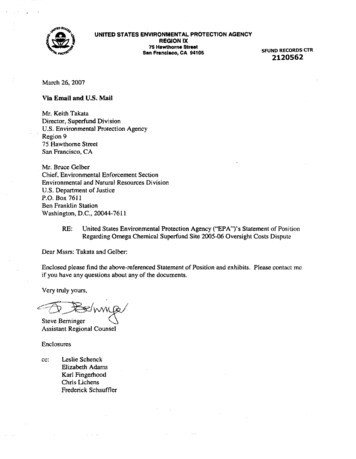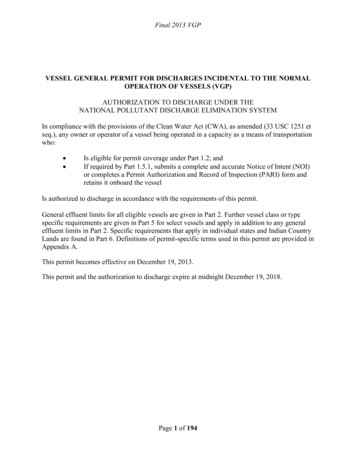
Transcription
Final 2013 VGPVESSEL GENERAL PERMIT FOR DISCHARGES INCIDENTAL TO THE NORMALOPERATION OF VESSELS (VGP)AUTHORIZATION TO DISCHARGE UNDER THENATIONAL POLLUTANT DISCHARGE ELIMINATION SYSTEMIn compliance with the provisions of the Clean Water Act (CWA), as amended (33 USC 1251 etseq.), any owner or operator of a vessel being operated in a capacity as a means of transportationwho: Is eligible for permit coverage under Part 1.2; andIf required by Part 1.5.1, submits a complete and accurate Notice of Intent (NOI)or completes a Permit Authorization and Record of Inspection (PARI) form andretains it onboard the vesselIs authorized to discharge in accordance with the requirements of this permit.General effluent limits for all eligible vessels are given in Part 2. Further vessel class or typespecific requirements are given in Part 5 for select vessels and apply in addition to any generaleffluent limits in Part 2. Specific requirements that apply in individual states and Indian CountryLands are found in Part 6. Definitions of permit-specific terms used in this permit are provided inAppendix A.This permit becomes effective on December 19, 2013.This permit and the authorization to discharge expire at midnight December 19, 2018.Page 1 of 194
Final 2013 VGPSigned and issued this 28th day of March, 2013Ira W. Leighton, Deputy Regional AdministratorEPA Region 1Signed and issued this 28th day of March, 2013Joan Leary Matthews, DirectorClean Water Division, EPA Region 2Signed and issued this 28th day of March, 2013Ramon Torres, Acting DirectorCaribbean Environmental Protection DivisionEPA Region 2Signed and issued this 28th day of March, 2013Jon M. Capacasa, DirectorWater Protection Division, EPA Region 3Signed and issued this 28th day of March, 2013James D. Giattina, DirectorWater Protection Division, EPA Region 4Signed and issued this 28th day of March, 2013Tinka G. Hyde, DirectorWater Division, EPA Region 5Signed and issued this 28th day of March, 2013William K. Honker, DirectorWater Quality Protection Division,EPA Region 6Signed and issued this 28th day of March, 2013Karen Flournoy, DirectorWater, Wetlands and Pesticides Division,EPA Region 7Signed and issued this 28th day of March, 2013Derrith R. Watchman-Moore, Assistant RegionalAdministratorOffice of Partnerships and RegulatoryAssistance, EPA Region 8Signed and issued this 28th day of March, 2013John Kemmerer, Acting DirectorWater Division, EPA Region 9Signed and issued this 28th day of March, 2013Daniel D. Opalski, DirectorOffice of Water and Watersheds, EPA Region 10Page 2 of 194
Final 2013 VGPTable of Contents:1.COVERAGE UNDER THIS PERMIT . 81.1Permit Structure . 81.2Eligibility . 81.2.1 General Scope of this Permit . 81.2.2 Vessel Discharges Eligible for Coverage . 81.2.3 Limitations on Coverage . 101.3Reserved . 121.4Permit Compliance. 121.5Authorization under this Permit . 131.5.1 How to Obtain Authorization. 131.5.2 Continuation of this Permit . 151.6Terminating Coverage . 151.6.1 Terminating Coverage for Vessels Required to Submit a Notice ofIntent (NOI) . 151.6.2 Terminating Coverage for Vessels not Required to Submit a Noticeof Intent (NOI) . 161.7Certification . 161.8Alternative Permits . 171.8.1 EPA Requiring Coverage under an Alternative Permit . 171.8.2 Permittee Requesting Coverage under an Alternative Permit . 171.9Permit Reopener Clause . 181.9.1 Modification of the VGP . 181.9.2 Water Quality Protection . 181.10 Severability . 191.11 State Laws . 191.12 Federal Laws . 191.13 Standard Permit Conditions . 191.14 Electronic Reporting Requirement . 191.15 Additional Notes . 202.EFFLUENT LIMITS AND RELATED REQUIREMENTS . 212.1Technology-Based Effluent Limits and Related Requirements Applicableto all Vessels . 212.1.1 Material Storage . 212.1.2 Toxic and Hazardous Materials . 212.1.3 Fuel Spills/Overflows . 222.1.4 Discharges of Oil Including Oily Mixtures . 222.1.5 Compliance with Other Statutes and Regulations . 232.1.6 General Training . 232.2Effluent Limits and Related Requirements for Specific DischargeCategories . 232.2.1 Deck Washdown and Runoff and Above Water Line Hull Cleaning . 232.2.2 Bilgewater/Oily Water Separator Effluent. 242.2.3 Ballast Water . 26Page 3 of 194
Final 2013 VGP2.2.42.2.52.2.62.2.72.2.82.2.92.3Anti-Fouling Hull Coatings/ Hull Coating Leachate . 44Aqueous Film Forming Foam (AFFF). 45Boiler/Economizer Blowdown. 45Cathodic Protection . 46Chain Locker Effluent. 46Controllable Pitch Propeller and Thruster Hydraulic Fluid andOther Oil-to-Sea Interfaces Including Lubrication Discharges fromPaddle Wheel Propulsion, Stern Tubes, Thruster Bearings,Stabilizers, Rudder Bearings, Azimuth Thrusters, Propulsion PodLubrication, and Wire Rope and Mechanical Equipment Subject toImmersion 472.2.10 Distillation and Reverse Osmosis Brine . 482.2.11 Elevator Pit Effluent . 482.2.12 Firemain Systems . 482.2.13 Freshwater Layup. 482.2.14 Gas Turbine Washwater . 482.2.15 Graywater 492.2.16 Motor Gasoline and Compensating Discharge . 512.2.17 Non-Oily Machinery Wastewater . 512.2.18 Refrigeration and Air Condensate Discharge . 512.2.19 Seawater Cooling Overboard Discharge (Including Non-ContactEngine Cooling Water; Hydraulic System Cooling Water,Refrigeration Cooling Water) . 522.2.20 Seawater Piping Biofouling Prevention . 522.2.21 Boat Engine Wet Exhaust . 522.2.22 Sonar Dome Discharge . 532.2.23 Underwater Ship Husbandry and Hull Fouling Discharges . 532.2.24 Welldeck Discharges . 542.2.25 Graywater Mixed with Sewage from Vessels . 542.2.26 Exhaust Gas Scrubber Washwater Discharge . 542.2.26.1Exhaust Gas Scrubber Washwater Discharge Standards . 552.2.27 Fish Hold Effluent. 58Additional Water Quality-Based Effluent Limits . 592.3.1 Water Quality-Based Effluent Limitations . 592.3.2 Discharges to Water Quality Impaired Waters . 593.CORRECTIVE ACTIONS . 613.1Problems Triggering the Need for Corrective Action. 613.2Corrective Action Assessment . 613.3Deadlines for Eliminating Problem . 623.4Effect of Corrective Action. 634.INSPECTIONS, MONITORING, REPORTING, AND RECORDKEEPING. 644.1Self Inspections and Monitoring . 644.1.1 Routine Visual Inspections . 644.1.2 Analytical Monitoring. 664.1.3 Comprehensive Annual Vessel Inspections . 66Page 4 of 194
Final 2013 VGP4.24.34.44.1.4 Drydock Inspection Reports . 67Recordkeeping . 684.2.1 Electronic Recordkeeping . 71Additional Recordkeeping for Vessels Equipped with Ballast Tanks . 71Reporting. 724.4.1 Annual Report . 724.4.2 Combined Annual Reports for Unmanned, Unpowered Barges orVessels less than 300 Gross Tons . 734.4.3 Reportable Quantities of Hazardous Substances or Oil . 734.4.4 Additional Reporting . 745.VESSEL-CLASS-SPECIFIC REQUIREMENTS . 755.1Large Cruise Ships (authorized to carry 500 people or more for hire) . 755.1.1 Additional Effluent Limits . 755.1.2 Monitoring Requirements . 775.1.3 Educational and Training Requirements . 795.2Medium Cruise Ships (authorized to carry 100 to 499 people for hire) . 805.2.1 Additional Effluent Limits . 805.2.2 Monitoring Requirements . 825.2.3 Educational and Training Requirements . 855.3Large Ferries . 865.3.1 Additional Effluent Limits . 865.3.2 Educational and Training Requirements . 865.4Barges (such as Hopper Barges, Chemical Barges, Tank Barges, FuelBarges, Crane Barges, Dry Bulk Cargo Barges). 875.4.1 Additional Effluent Limits . 875.4.2 Supplemental Inspection Requirements . 885.5Oil Tankers, Petroleum Tankers, and Bulk Chemical Carriers . 885.5.1 Additional Authorized Discharges . 885.5.2 Additional Effluent Limits . 885.5.3 Supplemental Inspection Requirements . 885.5.4 Educational and Training Requirements . 895.6Research Vessels . 895.6.1 Supplemental Authorized Discharges . 895.6.2 Additional Effluent Limits . 895.7Emergency and Rescue Vessels (Fire Boats, Police Boats) . 895.7.1 Supplemental Authorized Discharges . 905.7.2 Additional Effluent Limits . 906.SPECIFIC REQUIREMENTS FOR INDIVIDUAL STATES OR INDIAN COUNTRY LANDS . 916.1Alaska . 916.2Arizona. 926.3Arkansas . 936.4California . 946.5Connecticut . 976.6Georgia . 1006.7Hawaii . 101Page 5 of 194
Final 2013 .206.216.226.236.246.25Idaho . 107Illinois . 111Indiana. 112Iowa. 113Kansas . 114Maine . 114Michigan . 116Minnesota. 118Missouri . 122Nebraska . 122New Hampshire . 123New York . 124North Carolina . 128Ohio. 129Rhode Island . 132Vermont . 133Washington . 134Wisconsin. 137APPENDIX A – DEFINITIONS . 140APPENDIX B – EPA REGIONAL CONTACTS . 151APPENDIX C – AREAS COVERED . 152APPENDIX D – RESERVED . 152APPENDIX E – NOTICE OF INTENT (NOI) . 153APPENDIX F – NOTICE OF TERMINATION (NOT) . 161APPENDIX G – WATERS FEDERALLY PROTECTED WHOLLY OR IN PART FOR CONSERVATIONPURPOSES . 163APPENDIX H – ANNUAL REPORT. 181APPENDIX I – STANDARD DISCHARGE MONITORING REPORT . 190APPENDIX J – BALLAST WATER TREATMENT SYSTEM SENSORS, MEASUREMENTREQUIREMENTS AND APPROPRIATE EQUIPMENT FOR PHYSICAL/CHEMICALINDICATOR MONITORING . 191APPENDIX K – PERMIT AUTHORIZATION AND RECORD OF INSPECTION FORM (PARI) (FORVESSELS WHICH NEED NOT COMPLETE NOIS) . 194Page 6 of 194
Final 2013 VGPList of TablesTable 1: NOI Submission Deadlines/Discharge Authorization Dates .14Table 2: Indicator Organism Monitoring Parameters .31Table 3: Maximum Ballast Water Effluent Limits for Residual Biocides.33Table 4: Monitoring Schedule for Residual Biocides or Derivatives of the ResidualBiocide .34Table 5: Residual Biocides and Biocide Derivative Monitoring Requirements .34Table 6: Ballast Water Treatment to BAT Schedule .38Table 7: PAH Permit Limits in Exhaust Gas Scrubber Discharge .55Table 8: Nitrates Nitrites Permit Limits in Exhaust Gas Scrubber Discharge .56Page 7 of 194
Final 2013 VGP1.COVERAGE UNDER THIS PERMIT1.1Permit StructureThis permit is structured as follows:General requirements that apply to all eligible vessel discharges are found in Parts1 through 4;Specific additional requirements that apply to particular vessel classes are foundin Part 5; andSpecific additional requirements that apply in individual states or Indian CountryLands are found in Part 6. The Appendices A through K include definitions, the NOI form, the Notice of Termination(NOT) form, a list of waters federally protected for conservation purposes, the annual reportform, DMR forms, the Permit Authorization and Record of Inspection (PARI) form, andsupplemental information.1.2EligibilityYou must meet the following provisions to be eligible for coverage under this permit.1.2.1General Scope of this PermitThis permit is applicable to discharges incidental to the normal operation of a vessel identified inPart 1.2.2 into waters subject to this permit. These waters are “waters of the United States” asdefined in 40 Code of Federal Regulations (CFR) §122.2 (extending to the outer reach of the 3mile territorial sea as defined in section 502(8) of the CWA). This includes all navigable watersof the Great Lakes subject to the jurisdiction of the United States. Recreational vessels as definedin section 502(25) of the CWA are not subject to this permit. Such vessels are not subject toNPDES permitting under section 402 of the CWA, and are instead subject to regulation undersection 312(o) of the CWA. EPA expects that most vessels seeking coverage under this permitwill be greater than 79 feet in length; however, commercial fishing vessels and other nonrecreational vessels less than 79 feet are also eligible for permit coverage under this permit orthose vessels may seek coverage under EPA’s small Vessel General Permit (sVGP), as availableand appropriate. If auxiliary vessels or craft, such as lifeboats, rescue boats, or barges onboardlarger vessels require NPDES permit coverage, they are eligible for coverage under this permitand are covered by submission of the NOI for the larger vessels. For purposes of recordkeeping,inspections, and reporting, auxiliary vessels may be considered as part of the same entity as thelarger vessel. Nothing in this permit shall be interpreted to apply to a vessel of the Armed Forcesas defined in section 312(a)(14) of the CWA.1.2.2Vessel Discharges Eligible for CoverageUnless otherwise made ineligible under Part 1.2.3, the following discharge types are eligible forcoverage under this permit:1.2.2.1Deck Washdown and Runoff and Above Water Line Hull CleaningPage 8 of 194
Final 2013 VGP1.2.2.2Bilgewater/Oily Water Separator Effluent1.2.2.3Ballast Water1.2.2.4Anti-fouling Hull Coatings/Hull Coating Leachate1.2.2.5Aqueous Film Forming Foam (AFFF)1.2.2.6Boiler/Economizer Blowdown1.2.2.7Cathodic Protection1.2.2.8Chain Locker Effluent1.2.2.9Controllable Pitch Propeller and Thruster Hydraulic Fluid and other Oil SeaInterfaces including Lubrication Discharges from Paddle Wheel Propulsion,Stern Tubes, Thruster Bearings, Stabilizers, Rudder Bearings, AzimuthThrusters, and Propulsion Pod Lubrication, and Wire Rope and MechanicalEquipment Subject to Immersion1.2.2.10Distillation and Reverse Osmosis Brine1.2.2.11Elevator Pit Effluent1.2.2.12Firemain Systems1.2.2.13Freshwater Layup1.2.2.14Gas Turbine Washwater1.2.2.15GraywaterExcept that Graywater from commercial vessels within the meaning of CWA section 312 that areoperating in the Great Lakes is excluded from the requirement to obtain an NPDES permit (seeCWA section 502(6)), and thus is not within the scope of this permit.1.2.2.16Motor Gasoline and Compensating Discharge1.2.2.17Non-Oily Machinery Wastewater1.2.2.18Refrigeration and Air Condensate Discharge1.2.2.19Seawater Cooling Overboard Discharge (Including Non-Contact Engine CoolingWater; Hydraulic System Cooling Water, Refrigeration Cooling Water)1.2.2.20Seawater Piping Biofouling Prevention1.2.2.21Boat Engine Wet ExhaustPage 9 of 194
Final 2013 VGP1.2.2.22Sonar Dome Discharge1.2.2.23Underwater Ship Husbandry1.2.2.24Welldeck Discharges1.2.2.25Graywater Mixed with Sewage from Vessels1.2.2.26Exhaust Gas Scrubber Washwater Discharge1.2.2.27Fish Hold Effluent1.2.31.2.3.1Limitations on CoverageDischarges Not Subject to Former NPDES Permit Exclusion and VesselDischarges Generated from Vessels when they are Operated in a Capacity Otherthan as a Means of TransportationDischarges that are outside the scope of the former exclusion from NPDES permitting fordischarges incidental to the normal operation of a vessel as set out in 40 CFR §122.3(a), as ineffect on December 18, 2008, are ineligible for coverage under this permit. This permit does notapply to any vessel when it is operating in a capacity other than as a means of transportation. Forany discharges identified in this permit, discharges are not eligible if they contain materialsresulting from industrial or manufacturing processes onboard or other materials not derived fromthe normal operations of a vessel.Vessels when they are being used as an energy or mining facility, a storage facility, a seafoodprocessing facility, or when secured to the bed of waters subject to this permit or to a buoy forthe purpose of mineral or oil exploration or development are not eligible for coverage under thispermit. Furthermore, “floating” craft that are permanently moored to piers, such as “floating”casinos, hotels, restaurants, bars, etc. are not covered by the former vessel exclusion and wouldnot be covered by this vessel permit.1.2.3.2SewageDischarges of sewage from vessels, as defined in CWA section 502(6) and 40 CFR §122.2, arenot required to obtain NPDES permits. Instead, these discharges are regulated under section 312of the CWA and 40 CFR Part 140 and 33 CFR Part 159. Under CWA section 312(a)(6), thedefinition of sewage includes graywater discharges from “commercial vessels” (as defined inCWA section 312(a)(10)) operating on the Great Lakes. If a vessel operating on the Great Lakesis not a “commercial vessel” as defined in CWA section 312(a)(10), the vessel’s graywaterdischarges are eligible for coverage under this permit, and are subject to the additional permitrequirements in Part 2.2.15.1.1.2.3.3Used or Spent OilDischarges of used or spent oil no longer being used for their intended purposes are not eligiblefor coverage under this permit.Page 10 of 194
Final 2013 VGP1.2.3.4Garbage or TrashDischarges of rubbish, trash, garbage, or other such materials discharged overboard are noteligible for coverage under this permit. “Garbage” includes discharges of bulk dry cargo residuesas defined at 33 CFR §151.66(b) (73 Fed. Reg. 56492 (September 29, 2008)) and agriculturalcargo residues. Discharges of garbage are subject to regulation under 33 CFR Part 151, SubpartA.1.2.3.5Photo-Processing EffluentDischarges from photo-processing operations are not eligible for coverage under this permit.1.2.3.6Effluent from Dry Cleaning OperationsDischarges of spent or unused effluent from dry cleaning operations are not eligible for coverageunder this permit. This includes any spent or unused tetrachloroethylene (perchloroethylene)from these operations.1.2.3.7Discharges of Medical Waste and Related MaterialsDischarges of medical waste as defined in 33 USC 1362(20) are not eligible for coverage underthis permit. Discharges of spent or unused pharmaceuticals, formaldehyde, or other biohazardsno longer being used for their intended purposes are not eligible for coverage under this permit.For purposes of this permit, the liquid produced by dialysis treatment of humans is not deemed tobe “medical waste,” and, like other human body waste, is subject to regulation under CWA §312if introduced into marine sanitation devices, or under VGP Part 2.2.25 if added to a blackwatersystem combined with a graywater system. The direct overboard discharge of such liquid withouttreatment is not eligible for coverage under this permit.1.2.3.8Discharges of Noxious Liquid Substance ResiduesDischarges of noxious liquid substance residues subject to 33 CFR Part 151, Subpart A or 46CFR §153.1102 are not eligible for coverage under this permit.1.2.3.9Tetrachloroethylene (Perchloroethylene) and Trichloroethylene (TCE)DegreasersDischarges of tetrachloroethylene (perchloroethylene) and trichloroethylene (TCE) degreasers orother products containing tetrachloroethylene or trichloroethylene are not eligible for coverageunder this permit.1.2.3.10Discharges Currently or Previously Covered by an another NPDES PermitThe following discharges are not eligible for coverage under this permit: Vessel discharges covered, as of the effective date of this permit, under anindividual or a general NPDES permit other than the VGP, unless EPAP
Final 2013 VGP. Signed and issued this 28th day of March, 2013 Ira W. Leighton, Deputy Regional Administrator EPA Region 1 . Signed and issued this 28th day of March, 2013 Joan Leary Matthews, Director Clean Water Division, EPA Region 2 . Signed and issued this 28. th day of March, 2013 Ramon Torres, Acting Director
